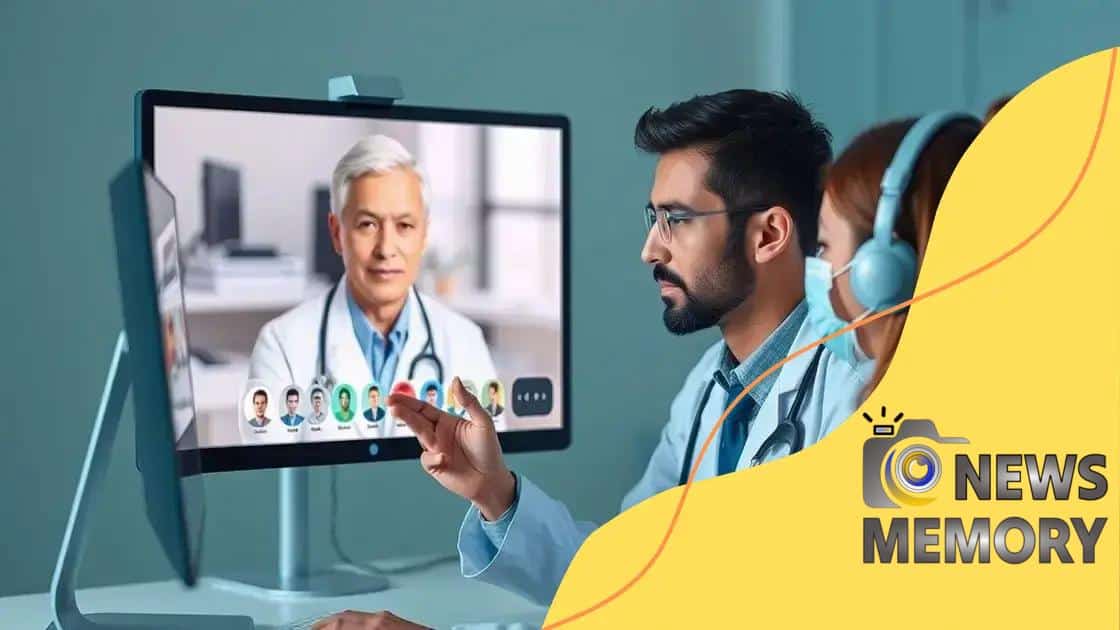The future of telemedicine in rural healthcare systems

The future of telemedicine in rural healthcare systems includes advancements like AI, wearable devices, and better internet access, all aimed at enhancing patient care and improving healthcare accessibility.
The future of telemedicine in rural healthcare systems holds great promise for expanding access to medical services, especially in hard-to-reach areas. Have you ever wondered how technology can bridge the gap between healthcare and remote communities? In this article, we will explore the transformative impact of telemedicine.
Understanding telemedicine and its significance
Understanding telemedicine is essential for appreciating its role in modern healthcare. This approach allows patients to connect with healthcare professionals remotely using technology. With telemedicine, barriers such as distance and time are minimized, enabling greater access to vital health services.
One key aspect of telemedicine is its ability to reach rural populations. In areas where healthcare facilities are limited, patients can consult with doctors through video calls or messaging. This not only helps in receiving timely medical advice but also in managing chronic conditions effectively.
Benefits of Telemedicine
Telemedicine provides numerous benefits:
- Increased access to specialists, regardless of location.
- Cost-effective solutions for patients.
- Reduced waiting times for appointments.
- Convenient consultations from home.
Additionally, telemedicine enhances patient engagement. When individuals can easily access their healthcare providers, they tend to take a more active role in their health management. This leads to improved health outcomes and a better overall patient experience.
Many healthcare systems worldwide are integrating telemedicine into their services, recognizing its growing significance. As technology advances, the potential for telemedicine continues to expand. The ongoing development of user-friendly platforms can make virtual visits even more effective and appealing.
Challenges in Understanding Telemedicine
However, understanding telemedicine also involves acknowledging some challenges. Not all patients are tech-savvy, which can create disparities in access. Some people may face internet connectivity issues, making it hard for them to benefit from these services. Therefore, education around telemedicine and its use is crucial to overcoming these barriers.
By embracing technology and promoting its advantages, healthcare systems can improve patient access and satisfaction. In conclusion, as we delve deeper into telemedicine, we see how its significance grows, particularly in rural healthcare systems. Its ability to connect patients with essential medical services cannot be understated, making it a vital part of our healthcare future.
Challenges in rural healthcare delivery
Challenges in rural healthcare delivery present a significant barrier to effective medical services for many communities. Despite advances in telemedicine, rural areas still face unique hurdles that need to be addressed.
A major challenge is the lack of healthcare providers. Many rural regions struggle to attract and retain qualified medical professionals. This leads to limited access to quality care, as patients may need to travel long distances for treatment. Moreover, some areas may not have any specialists available, forcing patients to rely on general practitioners.
Key Obstacles in Rural Healthcare
Several key obstacles impact rural healthcare delivery:
- Geographic isolation, making it hard for patients to reach medical facilities.
- Limited access to advanced medical technology and resources.
- Healthcare funding constraints affecting services offered.
- Inadequate transportation options for patients.
Additionally, financial limitations can hinder healthcare delivery. Many rural hospitals operate on tight budgets, resulting in fewer services and extended wait times. As a consequence, patients may delay seeking care, worsening their health conditions.
Navigating insurance issues can also pose a difficulty for rural residents. Some individuals might not have coverage options that meet their needs, leading to higher out-of-pocket costs. This can discourage people from using available healthcare services.
Technological Barriers
While telemedicine has great potential, it also comes with challenges. In rural areas, internet connectivity may be poor, making virtual appointments difficult. Patients may not have the equipment or skills to use telehealth applications effectively, which can limit participation.
Overcoming these challenges requires collaboration among healthcare providers, technology companies, and policymakers. Implementing targeted strategies can improve access to care, expand the range of services offered, and enhance the quality of care in rural healthcare systems. By addressing the unique factors that affect rural healthcare delivery, we can help ensure that everyone has access to the care they need.
The role of technology in improving telemedicine

The role of technology in improving telemedicine is crucial for enhancing healthcare delivery, especially in remote areas. With advancements in digital tools, patients can now receive care from the comfort of their homes.
One major technological advancement is video conferencing. This allows doctors and patients to communicate in real time, enabling better diagnosis and treatment plans. Patients can discuss their symptoms with a physician face-to-face, even if they are hundreds of miles apart.
Key Technologies Enhancing Telemedicine
Several key technologies are transforming telemedicine:
- Mobile applications: These apps enable patients to schedule appointments, access medical information, and consult with doctors on their smartphones.
- Wearable devices: Devices like smartwatches track vital signs and send data directly to healthcare providers, providing real-time monitoring.
- EHR systems: Electronic health records streamline the sharing of patient information among healthcare professionals, improving care coordination.
- Remote diagnostic tools: Tools like portable ultrasound machines allow for immediate assessments without requiring patients to travel.
Furthermore, technology enhances patient education. Informative websites and mobile resources equip patients with knowledge about their health conditions. This leads to more informed conversations with healthcare providers and better self-management of health.
Despite these advancements, challenges remain. Not every patient has access to necessary devices or reliable internet service. Addressing these gaps is essential for maximizing the potential of telemedicine in rural healthcare.
Future Innovations in Telemedicine
Looking ahead, emerging technologies like artificial intelligence (AI) and machine learning promise to further enhance telemedicine. AI can help analyze symptoms and provide preliminary diagnoses, making healthcare more efficient. As we continue to embrace these technologies, the potential for telemedicine to deliver high-quality care increases.
Case studies of successful telemedicine programs
Case studies of successful telemedicine programs provide valuable insights into how technology can transform healthcare delivery. These examples showcase the effectiveness of telemedicine in improving patient access and outcomes.
One notable case is the Project ECHO program launched in New Mexico. This innovative project connects rural healthcare providers with specialists in urban centers. Through regular virtual clinics, primary care providers receive training and support to manage complex cases. This approach has significantly improved care for patients with chronic conditions in remote areas.
Key Features of Project ECHO
Several key features contribute to the success of Project ECHO:
- Collaborative learning: Healthcare providers share experiences and knowledge in a supportive environment.
- Access to specialists: Local providers can consult with leading experts without needing to travel.
- Improved patient outcomes: Patients receive timely care, leading to better management of their health conditions.
Another impressive example is the Teladoc Health program, which has expanded access to healthcare services for millions. Teladoc allows patients to consult with physicians via smartphone apps or online platforms. This service is especially beneficial for those living in rural areas, where accessing medical facilities can be challenging.
Benefits of Teladoc Health
Key benefits of Teladoc Health include:
- Convenience: Patients can connect with doctors anytime, anywhere.
- Cost-effectiveness: Virtual visits often cost less than traditional in-person appointments.
- Diverse services: Teladoc offers a range of services, from general consultations to mental health support.
These case studies highlight the potential of telemedicine to break down barriers in healthcare. By learning from these successful programs, other healthcare systems can implement similar strategies to improve access and quality of care for their patients.
Future trends in rural telemedicine
Future trends in rural telemedicine are set to shape how healthcare is delivered in remote areas. As technology continues to evolve, we can expect significant changes that will improve patient care and accessibility.
One trend is the growing integration of artificial intelligence (AI) in telemedicine platforms. AI can assist in patient diagnostics and treatment recommendations, making virtual consultations more efficient. For instance, AI-driven chatbots can help triage patients and provide instant responses to common health queries.
Emerging Technologies
Another important trend is the use of wearable health devices. These devices can monitor vital signs and send real-time data to healthcare providers. This creates a continuous flow of information, allowing for better management of chronic conditions. Patients in rural areas can receive timely interventions based on data collected from their wearables without needing to visit a clinic.
- Telehealth platforms are expanding to include more services such as mental health support, dietary consultations, and pharmacy services.
- Remote surgery is gaining momentum, with advances in robotics allowing specialists to conduct procedures from afar.
- Blockchain technology is being explored to secure patient data, ensuring that medical records remain private and accessible only to authorized individuals.
Furthermore, improving internet access is vital for enhancing telemedicine services in rural areas. As broadband expands, more patients will be able to take advantage of telehealth services, reducing disparities in healthcare access. Governments and private sectors are investing in infrastructure projects to bring reliable internet to underserved communities.
Overall, the future of rural telemedicine is bright. With the right tools and resources, both healthcare providers and patients can benefit from these advancements. The focus on innovation will help bridge the gap in healthcare delivery and provide quality care for everyone, regardless of location.
FAQ – Frequently Asked Questions about the Future of Telemedicine in Rural Healthcare
What is telemedicine?
Telemedicine is the use of technology to provide healthcare services remotely, allowing patients to consult with healthcare professionals without needing to travel.
How does telemedicine benefit rural areas?
Telemedicine improves access to healthcare in rural areas by connecting patients with specialists and providers, reducing travel time and costs.
What technologies are driving telemedicine advancements?
Key technologies include artificial intelligence, mobile health apps, wearable devices, and improved internet connectivity.
Are there any challenges to implementing telemedicine?
Yes, challenges include internet access disparities, the need for patient education, and ensuring privacy and security of health data.





